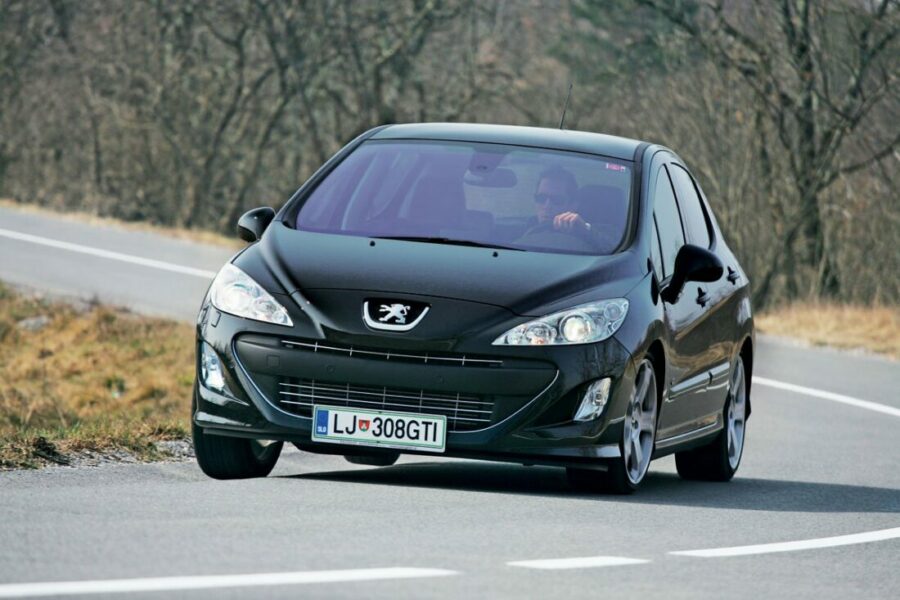
Rate Kratek: Peugeot 308 1.6 THP 200 GTi
Why is the 308 GTi not a real GTi? Because an otherwise good engine just didn't live up to what is currently expected and is normal for this class. The list of competitors capable of developing more than 200 "horses" is long (and we may have missed some): Astra OPC (240), Mégane RS (250), Giulietta 1750 TBi 16v QV (235), Mazda3 MPS 260). , Leon Cupra (240) (
But engine power is not the only reason. Also, the exterior isn't real, on the far-reaching GTi (the only real visible optical element from the outside is the spoiler on top of the tailgate), there's nothing particularly sporty about the interior, the steering wheel size belongs to a large, luxury sedan, not a pocket rocket.
And now that we've figured out what the 308 GTi isn't, we can see what it is: it's a powerful motorized, reasonably comfortable family car that will provide the driver with great sporting enjoyment. The 1,6-litre engine, as we've already found out, isn't really a racing gem, but it's smooth enough that it doesn't cause headaches over long distances, flexible enough (even at very low rpm) that you don't have to stretch all the time. to the lever (which, by the way, has too long and too loud movements), a six-speed gearbox with sporty short ratios and is economical enough when the driver wants it. Less than 10 liters of consumption is quite a decent result for a car weighing almost one and a half tons with 200 “horses”.
Moving on: the chassis.
Peugeot has always been known not only for its excellent compromise between sportiness and comfort, but also for its fun and enjoyable driving position. The 308 GTi is no exception. True, he could have had a stiffer suspension, but then it would have been less comfortable for the family. As it is now, it can also navigate bad roads without chatting with passengers. In corners, however, the sport is slightly lean and the steering is not too pronounced, with decisive intervention with the steering wheel, accelerator pedal or even the brakes can also be changed to rear end slip, which is easy to control. (At least) the 308 GTi is a true GTI for that matter.
For track performances, the chassis is still too soft, but for a few nice corners when there are no passengers in the car, it's perfect - just don't expect to find yourself at the exit of the corner when you howl and the hissing turbine monster under the hood rushed into side of the horizon. No, for this we need another "horse".
But then you also have to put up with (let's say) a steering wheel that wants to get out of the driver's hands (or at least rattle a little here and there), a tendency to wander around the wheels and when accelerating on bad roads, and a generally annoying sound on long journeys and consumption. energy corresponding. And then the compromise will no longer be so good - of course, for those who expect at least some refinement in addition to performance.
Let's put it this way: the 308 GTi isn't actually a real GTI, but it's a very good GT ... For the more extreme Peugeot, it's best to hit a 250bhp or even more powerful model labeled (say) RC. Ah, dreams ...
text: Dušan Lukič n photo: Aleš Pavletič
Peugeot 308 1.6 THP 200 GTi
Basic data
| Sales: | Peugeot Slovenia doo |
|---|---|
| Base model price: | 25.800 € |
| Test model cost: | 28.640 € |
| Calculate the cost of auto insurance | |
| Power: | 147kW (200 KM) |
| Acceleration (0-100 km / h): | 7,7 with |
| Maximum speed: | 235 km / h |
| Mixed flow ECE: | 6,9l / 100km |
Technical information
| engine: | 4-cylinder - 4-stroke - in-line - turbocharged petrol - displacement 1.598 cm3 - maximum power 147 kW (200 hp) at 5.500 rpm - maximum torque 255 Nm at 1.700–4.000 rpm. |
|---|---|
| Energy transfer: | Transmission: Front wheel drive engine - 6-speed manual transmission - tires 225/40 R 18 V (Bridgestone Blizzak LM - 25V). |
| Capacity: | 235 km/h top speed - 0-100 km/h acceleration in 7,7 s - fuel consumption (ECE) 9,2/5,5/6,9 l/100 km, CO2 emissions 159 g/km. |
| Mass: | empty vehicle 1.375 kg - permissible gross weight 1.835 kg. |
| External dimensions: | length 4.276 mm - width 1.815 mm - height 1.498 mm - wheelbase 2.608 mm - fuel tank 60 l. |
| Box: | 348-1.201 l |
Our measurements
| T = 6 ° C / p = 1.012 mbar / rel. vl. = 51% / odometer status: 5.427 km | |
| Acceleration 0-100km: | 8,1s |
|---|---|
| 402m from the city: | 16 years ( 149 km / h) |
| Flexibility 50-90km / h: | 5,5 / 7,0s (4th/5th) |
| Flexibility 80-120km / h: | 7,6 / 8,8s (5th/6th) |
| Maximum speed: | 235km / h (6.) |
| test consumption: | 9,9 l / 100km |
| Braking distance at 100 km / h: | 43,6m |
| AM table: | 40m |
evaluation
It's fast, it might be sporty, but it's not your classic family rocket. For this, the chassis lacks power and sharpness.
We praise and reproach
position on the road
flexible motor
price
rudder size
insufficient longitudinal displacement of the front seats
Transmission